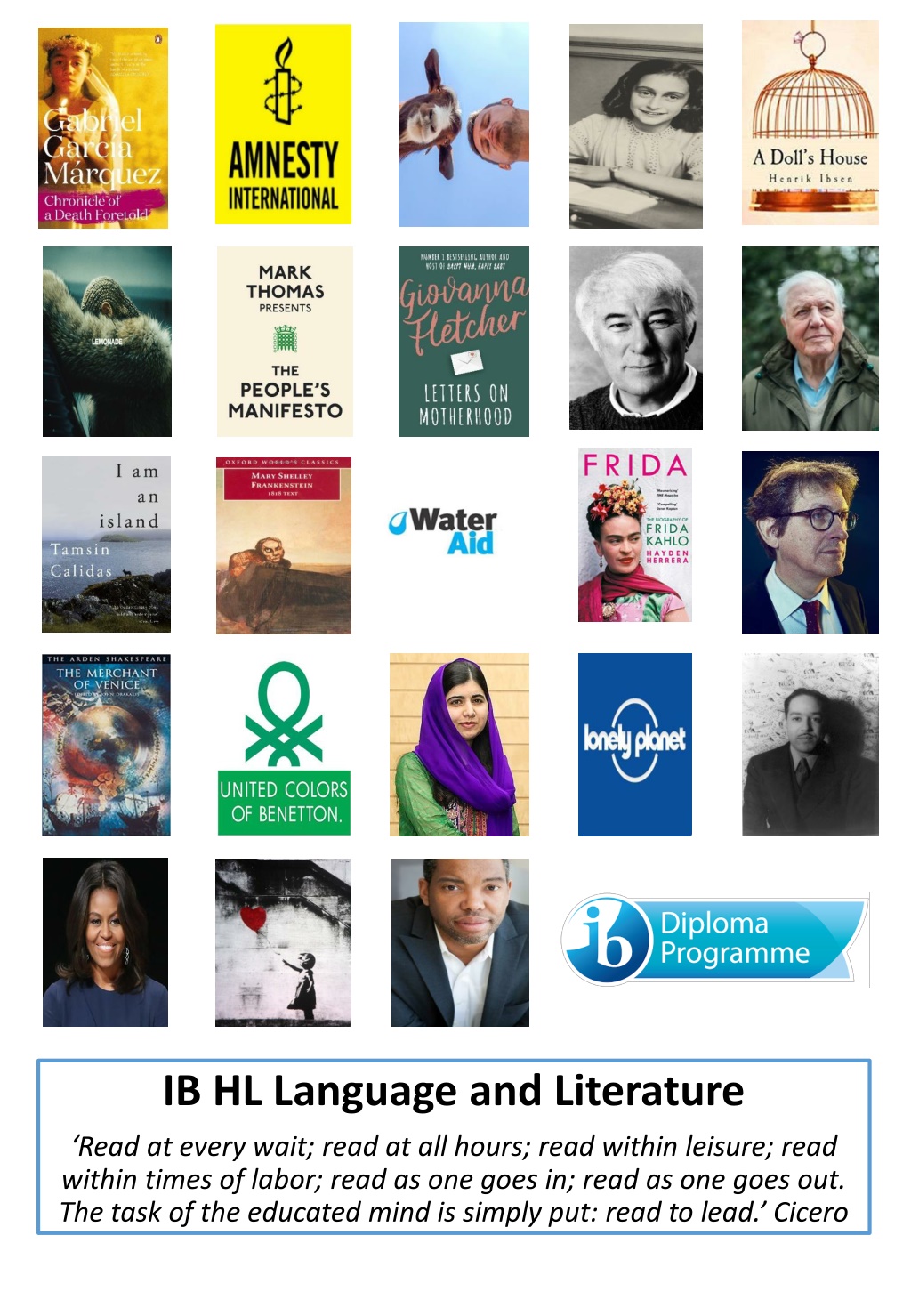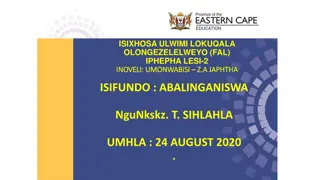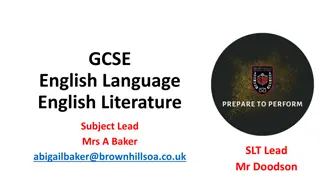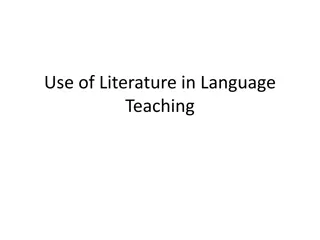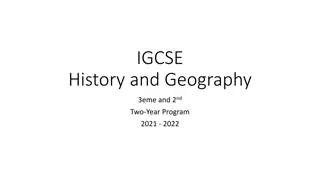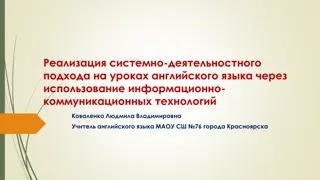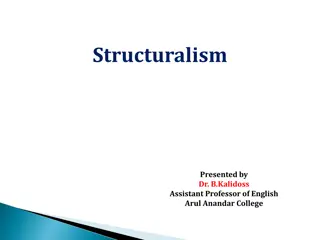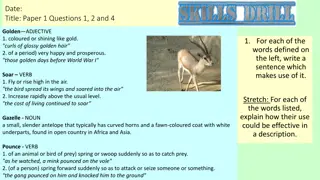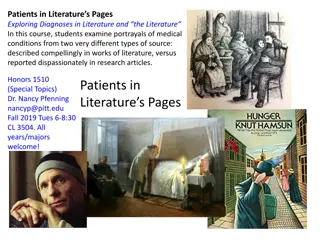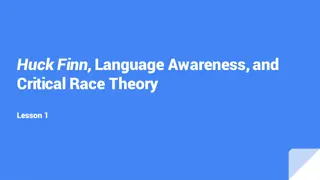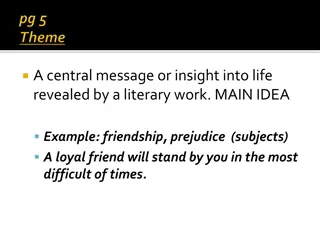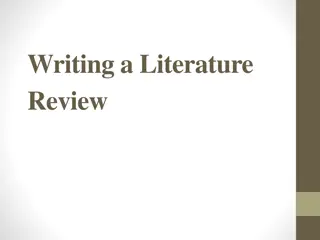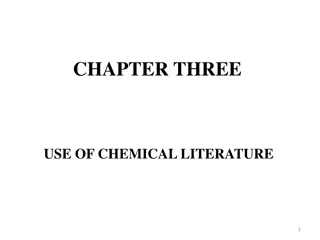Exploring Key Concepts in IB HL Language and Literature
Immerse yourself in the world of IB HL Language and Literature through a deep dive into key concepts such as imagination, creativity, communication, culture, identity, perspective, representation, and transformation. The course overview, assessment structure, and learner portfolio emphasize the importance of reading, analysis, and critical thinking, guiding students to lead through their interpretations and insights.
Download Presentation

Please find below an Image/Link to download the presentation.
The content on the website is provided AS IS for your information and personal use only. It may not be sold, licensed, or shared on other websites without obtaining consent from the author. Download presentation by click this link. If you encounter any issues during the download, it is possible that the publisher has removed the file from their server.
E N D
Presentation Transcript
IB HL Language and Literature Read at every wait; read at all hours; read within leisure; read within times of labor; read as one goes in; read as one goes out. The task of the educated mind is simply put: read to lead. Cicero
Course overview Course overview Paper 1 The Language Paper Paper 2 The Literature Paper 2 hours and 15 minutes 1 hour 45 minutes 35% 25% Two non-literary passages from two different text types. A guiding question will be included. Four general questions A comparative essay based on two literary works studied in the course. A separate analysis of each of the passages. Higher Level Essay Individual Oral 1200-1500 word essay. A prepared individual oral 10 minute presentation with 5 minutes then allocated to questions. 20% An essay following a line of inquiry in relation to a text or a work studied and linked to the key concepts. 20% A presentation analyzing a literary work and a non-literary body of work in relation to the global issue present in both. The Learner Portfolio: The Learner Portfolio acts as a reflection space as well as a space to practise and develop the skills needed for the different component parts of the IB. It also is an area to collate extra reading and further study.
Key concepts within the IB programme Key concepts within the IB programme Key considerations: What role does imagination play in the act of writing? How far does a reader s own imagination help to generate a range of potential meanings that are above and beyond established interpretations and how important is this? How important or desirable is it that a text is original? Creativity Key considerations: How does a writer communicate with their reader? How do writers make choices of style and structure to enhance this communication? What assumptions might a writer make about a reader s knowledge or views if they have a particular audience in mind? To what extent is a reader s engagement with the text important in order for communication to take place? Communication Key considerations: How does a text relate to its context of production and reception and to the respective values, beliefs and attitudes prevalent in them? What relationship exists between an individual text and the writing traditions that precede it? To what extent is the text a product of a particular cultural and literary context and how does it interact with it? Culture Key considerations: What perspective/s what voice/s or what character/s is/are encountered through a text? How far are the views expressed representative of the writer s identity? How are our identities and readers shaped by what we read? How important is the identity we bring to a text on our analysis of the act of reading and interpretation? Identity Key considerations: To what extent to do the perspectives on offer reflect the views of its author? How far do readers own perspectives influence their interaction with a text? How does a variety of perspectives widen the interpretation of a text? How far do the contexts of production and reception influence and shape perspectives? Perspective Key considerations: How far do language and literature represent reality? To what extent do form and structure interact with, and relate to, meaning? Representation Key considerations: How far do texts refer to one another, utilize elements from other texts and transform them to suit a different aesthetic or communicative purpose? How far is the process of reading a text transformative both for the text and the reader? To what extent do personal interpretations transform a text? What impact does a text have on a reader that might lead to action and to the transformation of reality? Transformation
Global issues: Fields of inquiry Global issues: Fields of inquiry Areas covered: aspects of family, class, race, ethnicity, nationality, religion, gender and sexuality and the way these impact on individuals and societies. Issues concerning migration, colonialism and nationalism. Culture, identity and community Areas covered: beliefs and values nurtured in particular societies and the ways they shape individuals, communities and educational systems. Tensions that arise when there are conflicts of beliefs and values and ethics. Beliefs, value and education Areas covered: aspects of rights and responsibilities, the workings and structures of governments and institutions. Hierarchies of power, the distribution of wealth and resources, the limits of justice and the law, equality and inequality, and peace and conflict. Power, politics and justice Areas covered: aesthetic inspiration, creation, craft and beauty. Shaping and challenging of perceptions through art, and the function, value and effects of art in society. Arts, creativity and imagination Areas covered: relationships between humans and the environment, implications of technology and media for society, scientific development and progress. Science, technology and environment
Areas of exploration Areas of exploration 1. 2. 3. Why and how do we study language and literature? How are we affected by texts in various ways? In what ways is meaning constructed, negotiated, expressed and discovered? How does language use vary among text types and among literary forms? How does the structure or style of a text affect meaning? How do texts offer insights and challenges? Readers, writers and texts 4. 5. 6. 1. How important is cultural or historical context to the production and reception of a text? How do we approach texts from different times and cultures to our own? To what extent do texts offer insight into another culture? How does the meaning and impact of a text change over time? How do texts reflect, represent or form a part of cultural practices? How does language represent social distinction and identities? Time and space 2. 3. 4. 5. 6. 1. How do texts adhere to and deviate from conventions associated with literary forms and genres or text types? How do conventions and systems of reference evolve over time? In what ways can diverse texts share points of similarity? How valid is the notion of a classic text? How can texts offer multiple perspectives of a single issue, topic or theme? In what ways can comparison and interpretation be transformative? Intertextuality 2. 3. 4. 5. 6.
Unit 1: To what extent do texts offer insights into other cultures? What will I be studying within this unit? Literary text Chronicle of a Death Foretold by Gabriel Garcia Marquez Santiago Nasar is brutally murdered in a small town by two brothers. All the townspeople knew it was going to happen - including the victim. But nobody did anything to prevent the killing. Twenty seven years later, a man arrives in town to try and piece together the truth from the contradictory testimonies of the townsfolk. To at last understand what happened to Santiago, and why. . . Bodies of work Amnesty International Campaigns A global movement of more than 7 million countries and territories who campaign to end abuses of human rights. Dan Flying Solo A travel photographer and travel blogger focused on Asia, Europe and Australia. The Diary of Anne Frank A diary kept by Anne Frank while she was in hiding for two years with her family during the Nazi occupation of the Netherlands. Unit 2: Communication is central to the success of relationships. How far would you agree? What will I be studying within this unit? Literary text A Doll s House by Henrik Ibsen A Doll's House (Norwegian: Et dukkehjem; also translated as A Doll House) is a three- act play in prose by Henrik Ibsen. It premiered at the Royal Theatre in Copenhagen, Denmark, on 21 December 1879, having been published earlier that month. The play is significant for its critical attitude toward 19th century marriage norms. It aroused great controversy at the time, as it concludes with the protagonist, Nora, leaving her husband and children because she wants to discover herself. Ibsen was inspired by the belief that "a woman cannot be herself in modern society," since it is "an exclusively male society, with laws made by men and with prosecutors and judges who assess feminine conduct from a masculine standpoint." Bodies of work Beyonce s Lemonade A visual album that relates the emotional journey of Beyonce after her husband Jay Z s infidelity. The People s Manifesto A satirical political manifesto. Letters on Motherhood A collection of heartfelt and deeply poignant letters written by Giovanna to her three young sons, her husband and the family and friends who have supported her.
Unit 3: How does language represent our awe and fear for the natural world? What will I be studying within this unit? Literary text The poetry of Seamus Heaney Seamus Heaney is widely recognized as one of the major poets of the 20th century. A native of Northern Ireland, Heaney was raised in County Derry, and later lived for many years in Dublin. He was the author of over 20 volumes of poetry and criticism, and edited several widely used anthologies. He won the Nobel Prize for Literature in 1995"for works of lyrical beauty and ethical depth, which exalt everyday miracles and the living past. As Blake Morrison noted in his work Seamus Heaney,the author is "that rare thing, a poet rated highly by critics and academics yet popular with 'the common reader.'" Part of Heaney's popularity stems from his subject matter modern Northern Ireland, its farms and cities beset with civil strife, its natural culture and language overrun by English rule. The New York Review of Books essayist Richard Murphy described Heaney as "the poet who has shown the finest art in presenting a coherent vision of Ireland, past and present." Heaney's poetry is known for its aural beauty and finely-wrought textures. Bodies of work The speeches of Greta Thunberg Greta Thuberg is a Swedish environmentalist activist who has gained international recognition for promoting the view that humanity is facing an existential crisis arising from climate change. The documentaries of David Attenborough David Attenborough is an English broadcaster and natural historian. His most successful series was entitled life surveying the animal and plant life on Earth. I am an Island by Tamsin Calidas. Tamsin Calidas is a writer and photographer living in the wilds of the Scottish Hebrides. She gave up a successful career in 2004 to move to a tiny, remote island in Scotland. This memoir explores her experiences. Unit 4: What influence does experience have on transforming behaviour? What will I be studying within this unit? Literary text Frankenstein by Mary Shelley A stunning, enduring horror story about the dangers of Science, as the ambitious Victor Frankenstein takes his powers of creation too far and pays a terrible price when he gives life to a terrible monster. Heartbreaking, darkly funny and full of striking gothic images, FRANKENSTEIN is a true classic. Bodies of work Waster Aid appeals Water Aid UK is a charity working to get clean water, decent toilets and good hygiene to everyone, everywhere. The articles of Alan Rusbridger Alan Rusbridger is a British Journalist and former editor- in-chief of The Guardian. The biography of Frida Kahlo Frida Kahlo was a Mexican painter known for her many portraits, self- portraits and works inspired by the nature and artifacts of Mexico.
Unit 5: To what extent are texts integral in widening our perspective on the world? What will I be studying within this unit? Literary text The Merchant of Venice by William Shakespeare Antonio, a Venetian merchant, wishes to help his friend get money to impress a rich heiress. But he is forced to borrow the sum from a cynical, abused Jewish moneylender, Shylock, and signs a chilling contract to honour the debt with a pound of his own flesh. An ambiguous, complex and controversial comedy, The Merchant of Venice explores prejudice, marriage, money and the true nature of justice in an unforgiving world. Bodies of work United Colors of Benetton advertising One of the most well- know fashion companies in the world. Their advertising campaigns have always been social talking points and aroused cultural debate. Interviews with Malala Yousafzai A female activist from Pakistan who is most known for her human rights advocacy. In 2012, Malala was shot by a Taliban gunman in an assassination attempt. Lonely Planet Guidebook A large travel guide book publisher offering insights into countries all over the world. Unit 6: How far does the production of a text help individuals to express feelings around their own identity? What will I be studying within this unit? Literary text The poetry of Langston Hughes Langston Hughes was a central figure in the Harlem Renaissance, the flowering of black intellectual, literary, and artistic life that took place in the 1920s in a number of American cities, particularly Harlem. A major poet, Hughes also wrote novels, short stories, essays, and plays. He sought to honestly portray the joys and hardships of working-class black lives, avoiding both sentimental idealization and negative stereotypes. As he wrote in his essay The Negro Artist and the Racial Mountain, We younger Negro artists who create now intend to express our individual dark- skinned selves without fear or shame. If white people are pleased we are glad. If they are not, it doesn t matter. We know we are beautiful. And ugly too. Bodies of work The speeches of Michelle Obama Michelle Obama was the first lady from 2009 to 2017. As first lady, Obama served as a role model for women and worked as an advocate for poverty awareness and education amongst other things. Magazine articles Ta-Nehisi Coates Ta-Nehisi Coates is an American author and journalist who gained wide readership during his time as national correspondent at The Atlantic. The work of Banksy Banksy is an anonymous English- based street artist, vandal, political activist and film director. His street art is both satirical and subversive.
Assessment criterion: Paper 1 Assessment criterion: Paper 1 Criterion A: Understanding and Interpretation The response demonstrates a thorough and perceptive understanding of the literal meaning of the text. There is a convincing and insightful interpretation of larger implications and subtleties of the text. References to the text are well-chosen and effectively support the candidate s ideas. 5 marks The response demonstrates a thorough understanding of the literal meaning of the text. There is a convincing interpretation of many implications of the text. References to the text are relevant and support the candidate s ideas. 4 marks The response demonstrates an understanding of the literal meaning of the text. There is a satisfactory interpretation of some implications of the text. References to the text are relevant and support the candidate s ideas. 3 marks The response demonstrates some understanding of the literal meaning of the text. References to the text are appropriate. 2 marks The response demonstrates little understanding of the literal meaning of the text. References to the text are infrequent or are rarely appropriate. 1 mark Criterion B: Analysis and Evaluation The response demonstrates an insightful and convincing analysis of textual features and / or authorial choices. There is a very good evaluation of how such features and / or choices shape meaning. 5 marks The response demonstrates an appropriate and at times insightful analysis of textual features and / or authorial choices. There is a good evaluation of how such features and / or choices shape meaning. 4 marks The response demonstrates an appropriate analysis of textual features and / or authorial choices. 3 marks The response demonstrates some appropriate analysis of textual features and / or authorial choices, but is reliant on description. 2 marks The response is descriptive and / or demonstrates little relevant analysis of textual features and / or authorial choices. 1 mark Criterion C: Focus and organisation The presentation of ideas is effectively organised and coherent. The analysis is well focused. 5 marks The presentation of ideas is well organised and mostly coherent. The analysis is adequately developed. 4 marks The presentation of ideas is adequately organised in a generally coherent manner. There is some focus in the analysis. 3 marks Some organisation is apparent in the presentation of ideas. There is little focus in the analysis. 2 marks Little organisation is apparent in the presentation of ideas. No discernible focus is apparent in the analysis. 1 mark Criterion D: Language Language is very clear, effective, carefully chosen and precise, with a high degree of accuracy in grammar, vocabulary and sentence construction; register and style are effective and appropriate to the task. 5 marks Language is clear and carefully chosen, with a good degree of accuracy in grammar, vocabulary and sentence construction; register and style are consistently appropriate to the task. 4 marks Language is clear and carefully chosen with an adequate degree of accuracy in grammar, vocabulary and sentence construction despite some lapses; register and style are mostly appropriate to the task. 3 marks Language is sometimes clear and carefully chosen; grammar, vocabulary and sentence construction are fairly accurate, although errors and inconsistencies are apparent; the register and style are to some extent appropriate to the task. 2 marks Language is rarely clear and appropriate; there are many errors in grammar, vocabulary and sentence construction and little sense of register and style. 1 mark
Assessment criterion: Paper 2 Assessment criterion: Paper 2 Criterion A: Understanding and Interpretation 9-10 marks There is perceptive knowledge and understanding of the works and a persuasive interpretation of their implications in relation to the question answered. The essay offers an insightful interpretation of the similarities and differences between the works used in relation to the question. 7-8 marks There is good knowledge and understanding of the works and a sustained interpretation of their implications in relation to the question answered. The essay offers a convincing interpretation of the similarities and differences between the works used in relation to the question. 5-6 marks There is satisfactory knowledge and understanding of the works and an interpretation of their implications in relation to the question answered. The essay offers a satisfactory interpretation of the similarities and differences between the works used in relation the question. 3-4 marks There is some knowledge and understanding of the works in relation to the question answered. There is a superficial attempt to compare and contrast the works used in relation to the question. 1-2 marks There is little knowledge and understanding of the works in relation to the question answered. There is little meaningful comparison and contrast of the works used in relation to the question. Criterion B: Analysis and Evaluation 9-10 marks The essay demonstrates a consistently insightful and convincing analysis of textual features and / or broader authorial choices. There is a very good evaluation of how such features and / or choices contribute to meaning. There is a very good comparison and contrast of the authors choices in the works selected. 7-8 marks The essay demonstrates an appropriate and at times insightful analysis of textual features and / or broader authorial choices. There is a good evaluation of how such features and / or choices shape meaning. There is a good comparison and contrast of the author s choices in the works selected. 5-6 marks The essay demonstrate a generally appropriate analysis of textual features and / or broader authorial choices. There is an adequate comparison and contrast of the authors choices in the works selected. 3-4 marks The essay demonstrates some appropriate analysis of textual features and / or broader authorial choices, but is reliant on description. There is a superficial comparison and contrast of the author s choices in the works selected. 1-2 marks The essay is descriptive and / or demonstrates little relevant analysis of textual features and / or the broader authorial choices. Criterion C: Focus and organisation The essay maintains a clear and sustained focus on the task; treatment of the works is well-balanced. The development of ideas is logical and convincing; ideas are connected in a cogent manner. 5 marks The essay maintains a mostly clear and sustained focus on the task; treatment of the works is balanced. The development of ideas is logical; ideas are cohesively connected. 4 marks The essay maintains a focus on the task, despite some lapses; treatment of the works is mostly balanced. The development of ideas is mostly logical; ideas are generally connected in a cohesive manner. 3 marks The essay only sometimes focuses on the ask, and treatment of the works may be unbalanced. There are some connections between ideas, but these are not always coherent. 2 marks The essay rarely focuses on the task. There are few connections between ideas 1 mark Criterion D: Language Language is very clear, effective, carefully chosen and precise, with a high degree of accuracy in grammar, vocabulary and sentence construction; register and style are effective and appropriate to the task. 5 marks Language is clear and carefully chosen, with a good degree of accuracy in grammar, vocabulary and sentence construction; register and style are consistently appropriate to the task. 4 marks Language is clear and carefully chosen with an adequate degree of accuracy in grammar, vocabulary and sentence construction despite some lapses; register and style are mostly appropriate to the task. 3 marks Language is sometimes clear and carefully chosen; grammar, vocabulary and sentence construction are fairly accurate, although errors and inconsistencies are apparent; the register and style are to some extent appropriate to the task. 2 marks Language is rarely clear and appropriate; there are many errors in grammar, vocabulary and sentence construction and little sense of register and style. 1 mark
Assessment criterion: Higher Level Essay Assessment criterion: Higher Level Essay Criterion A: Understanding and Interpretation There is excellent knowledge and understanding of the work or text shown through the essay and a persuasive interpretation of their implications in relation t the chosen topic. References to the work or text are well-chosen and effectively support the candidate s ideas in relation to the chosen topic. 5 marks There is good knowledge and understanding of the work or text shown through the essay and a sustained interpretation of its implication in relation to the topic chosen. References to the work or text are relevant and support the candidate s ideas in relation to the chosen topic. 4 marks There is satisfactory knowledge and understanding of the work or text shown through the essay and an interpretation of their implications in relation to the topic chosen. References to the work or text are generally relevant and mostly support the candidate s ideas in relation to the chosen topic. 3 marks There is some knowledge and understanding of the work or text shown through the essay in relation to the topic chosen. References to the work or text are a time appropriate in relation to the chosen topic. 2 marks There is little knowledge and understanding of the work or text shown through the essay in relation to the topic chosen. References to the work or text are infrequent or are rarely appropriate in relation to the chosen topic. 1 mark Criterion B: Analysis and Evaluation 5 marks The essay demonstrates a consistently insightful and convincing analysis and evaluation of textual features and the author s broader choices in relation to the chosen topic. 4 marks The essay demonstrates an appropriate and at times insightful analysis and evaluation of textual features and the author s broader choices in relation to the chosen topic. 3 marks The essay demonstrate a generally appropriate analysis and evaluation of textual features and the author s broader choices in relation to the chosen topic. 2 marks The essay demonstrates some appropriate analysis of textual features and the author s broader choices in relation to the chosen topic, but is reliant on description. 1 mark The essay is descriptive and / or demonstrates little relevant analysis of textual features and / or the author s broader choices in relation to the chosen topic. Criterion C: Focus and organisation The essay is effectively organised and cohesive. The line of inquiry is well-developed. Supporting examples are well integrated into the structure of the sentences and paragraphs. 5 marks The essay is well organised and mostly cohesive. The line of inquiry is adequately developed. Supporting examples are mostly well integrated into the structure of the sentences and paragraphs. 4 marks The essay is adequately organised in a generally cohesive manner. There is some development of the line of inquiry. Supporting examples are sometimes integrated into the structure of the sentences and paragraphs. 3 marks Some organisation is apparent. There is little development of a line of inquiry. Supporting examples are rarely integrated into the structure of the sentences and paragraphs. 2 marks Little organisation is present. No discernible line of inquiry is apparent in the essay. Supporting examples are not integrated into the structure of the sentences and paragraphs. 1 mark Criterion D: Language Language is very clear, effective, carefully chosen and precise, with a high degree of accuracy in grammar, vocabulary and sentence construction; register and style are effective and appropriate to the task. 5 marks Language is clear and carefully chosen, with a good degree of accuracy in grammar, vocabulary and sentence construction; register and style are consistently appropriate to the task. 4 marks Language is clear and carefully chosen with an adequate degree of accuracy in grammar, vocabulary and sentence construction despite some lapses; register and style are mostly appropriate to the task. 3 marks Language is sometimes clear and carefully chosen; grammar, vocabulary and sentence construction are fairly accurate, although errors and inconsistencies are apparent; the register and style are to some extent appropriate to the task. 2 marks Language is rarely clear and appropriate; there are many errors in grammar, vocabulary and sentence construction and little sense of register and style. 1 mark
Assessment criterion: Individual oral Assessment criterion: Individual oral Criterion A: Understanding and Interpretation 9-10 marks There is excellent knowledge and understanding of the extracts and of the works / texts and a persuasive interpretation of their implications in relation to the global issue. References to the extracts and to the works/texts are well-chosen and effectively support the candidate s ideas. 7-8 marks There is good knowledge and understanding of the extracts and the works/ texts and a sustained interpretation of their implications in relation to the global issue. References to the extracts and to the works / texts are relevant and support the candidate s ideas. 5-6 marks There is a satisfactory knowledge and understanding of the extracts and the works/ texts and an interpretation of their implications in relation to the global issue. References to the extracts and to the works / texts are generally relevant and mostly support the candidate s ideas. 3-4 marks There is some knowledge and understanding of the extracts and the works / texts in relation to the global issue. References to the extracts and ot the works / texts are at times appropriate. 1-2 marks There is little knowledge and understanding of the extracts and the works / texts in relation to the global issue. References to the extracts and to the works / texts are infrequent or are rarely appropriate. Criterion B: Analysis and Evaluation 9-10 marks Analysis and evaluation of the extracts and their works / texts are relevant and insightful. There is a thorough and nuanced understanding of how authorial choices are used to present the global issue. 7-8 marks Analysis and evaluation of the extracts and their works / texts are relevant and at times insightful. There is a good understanding of how authorial choices are used to present the global issue. 5-6 marks The oral is analytical in nature, and evaluation of the extracts and their works / texts is mostly relevant. Authorial choices are identified and reasonably understood in relation to the presentation of the global issue. 3-4 marks The oral contains some relevant analysis but it is reliant on description. Authorial choices are identified, but are vaguely treated and / or only partially understood in relation to the presentation of the global issue. 1-2 marks The oral is descriptive or contains no relevant analysis. Authorial choices are seldom identified and, if so, are poorly understood in relation to the presentation of a global issue. Criterion C: Focus and organisation 9-10 marks The oral maintains a clear and sustained focus on the task; treatment of the extracts and works / texts is well- balanced. The development of ideas is logical and convincing; ideas are connected in a cogent manner. 7-8 marks The oral maintains a mostly clear and sustained focus on the task; treatment of the extracts and works / texts is balanced. The development of ideas is logical; ideas are cohesively connected in an effective manner. 5-6 marks The oral maintains a focus on the task, despite some lapses; treatment of the extract and works / texts is mostly balanced. 3-4 marks The oral only sometimes focuses on the task, and treatment of the extracts, and of the works / texts may be unbalanced. There are some connections between ideas, but these are not always coherent. 1-2 marks The oral rarely focused on the task. There are few connections between ideas. Criterion D: Focus and organization 9-10 marks The language is clear, accurate and varied; occasional errors do not hinder communication. Vocabulary and syntax are varied and create effect. Elements of style (for example, register, tone and rhetorical devices) are appropriate to the task and enhance the oral. 7-8 marks The language is clear and accurate; occasional errors do not hinder communication. Vocabulary and syntax are appropriate and varied. Elements of style (for example, register, tone and rhetorical devices) are appropriate to the task and somewhat enhance the oral. 5-6 marks The language is clear; errors do not hinder communication. Vocabulary and syntax are appropriate to the task but simple and repetitive. Elements of style (for example, register, tone and rhetorical devices) are appropriate to the task and neither enhance nor detract from the oral. 3-4 marks The language is generally clear; errors sometimes hinder communication. Vocabulary and syntax are often imprecise with inaccuracies. Elements of style (for example, register, tone and rhetorical devices) are often inappropriate to the task and detract from the oral. 1-2 marks The language is rarely clear or accurate; errors often hinder communication. Vocabulary and syntax are imprecise and frequently inaccurate. Elements of style (for example, register, tone and rhetorical devices) are inappropriate to the task and detract from the oral.
